| Hot Rod for 2000: Dual Celeron
by Leonard "Viking1" Hjalmarson |
||||
|
Terms of Endearment But first let's define some terms. What, dare we ask, is a PPGA Celeron? The PPGA is a new CPU package recently released by Intel, the 370-pin Plastic Pin Grid Array connector, or PGA-370. The CPU comes housed in a small plastic package which contains the necessary pin contacts to the motherboard. Remember plugging your old Pentium CPU directly into the mainboard? That's it!
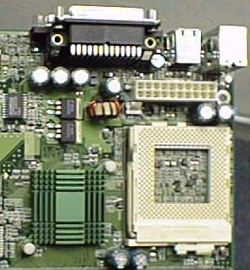 Socket 370. Socket-370 might be great for some people, but it limits your upgrade options and there are no dual CPU options. And dual CPUs, dear reader, is what this article is about!
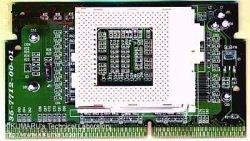 PPGA to Slot 1 Adapter. The Dual Celeron Dance I have assembled the components of the average dream machine, my own 1969 Camaro, complete with high rise manifold, dual carburetors, headers, high lift cam, electronic ignition and 3.47 gears in the rear end! Here is a listing of the components I used to build this dual processor system:
Since WIN 98 does not support multiprocessing it means running NT4 or WIN2000, which is still in beta. Even at this stage the gains are nowhere near 100%, and in fact in many games there is no gain at all. Falcon 4, MiG Alley, Descent III and others are multithreaded but the gains seem to be more related to the operating system than the second processor since these games haven't really been optimized for SMP. In spite of that, with the price of the Celeron as low as it is, there is no good reason a dedicated gamer shouldn't consider building such a system. Suppose, for example, that you need to run a dedicated server while also doing the important personal work.. er, like running Falcon 4. Or maybe you need to duplicate CDs while running Descent III? A dual processor system under WIN2000 would be the hot rod you need. |
I chose the 400A for my dual processor system because I discovered that Intel has locked the bus ratio multipliers on the Celeron PPGA. This means that the only way to overclock this CPU is to increase the bus speed. The 400A is locked at 6x, so running the bus at 83MHz gives me 500MHz, a nice easy speed for my hot rod. (The 466 is locked at 7x and might be a great choice for 7x83 = 583, but early tests show that the 466 is not easily clocked beyond 7x75. The 466 is the first Celeron that will be available ONLY in the socket 370 variety.)
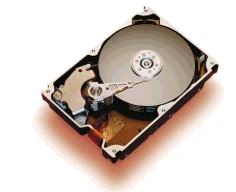 I chose the Quantum Viking II for storage because it is the best price/performance ratio out there for the new breed of SCSI Ultra II hardware. SCSI II technology is continuing to advance, and the LVD (low voltage differential) interface allows double the transfer rate of the previous generation, up to 80 MB/second with dual drives, 40 MB/second for a single (4 times the rate of UDMA.) The Viking II has a 7.5 ms access time and 7,200 RPM rotational speed on a 68 pin interface. This carburetor should be able to supply enough fuel to keep all eight pistons pumping, or at least two CPUs. Slocket to Me It takes two to tango. In order to mount a pair of PPGA Celerons in a SLOT 1 mainboard we need a socket-370 to slot-1 converter, or Slocket, for short. This converter allows you to take the Celeron CPU and put it back onto a SEPP package and then insert it into any SLOT 1, including a dual SLOT 1 mainboard. This is where it gets interesting. With their first release of their MS-6905 slocket adapter a single wire had to be added to enable a dual processor rig. But version 1.1 is now in production, allowing dual celeron configuration in a Slot 1 mainboard with no other modifications needed! No fuss, no muss! Here is a schematic followed by a photo of the unit I have in hand.
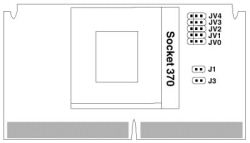
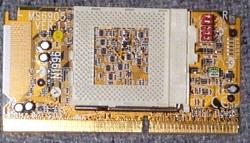 Other features of this socket adapter include the ability to directly manipulate the CPU core voltage. The MS-6905 supports the following core voltages: 1.8V, 1.85V, 1.9V, 1.95V, 2.0V, 2.05V, 2.1V, 2.2V, 2.3V, 2.4V, 2.5V, 2.6V. Why is this important? Not all CPUs will allow you to push them to higher speeds without also increasing core voltage. In my case I was able to reach 6x75 at the default core voltage of 2.0. Finally, this adapter includes an overclocking jumper which when shorted causes the board to automatically detect whether to use a 66MHz or 100MHz FSB. When the J1 jumper is open, however, the MSI adapter "tricks" your motherboard into thinking that the Celeron is actually a 100MHz CPU, and the motherboard accordingly raises the bus speed to 100MHz. Many motherboards allow you to control the FSB directly on themselves, but there are some motherboards which will detect a Celeron processor and lock the FSB at 66MHz.
Go to Part III
|
|||
|
Copyright © 1997 - 2000 COMBATSIM.COM, INC. All Rights Reserved. Last Updated May 5th, 1999 |
||||
